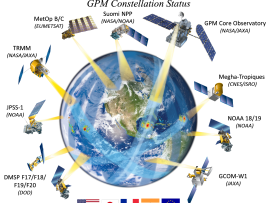Image Bottom Full
Co-led by NASA and the Japan Aerospace and Exploration Agency (JAXA), the Tropical Rainfall Measurement Mission (TRMM) and Global Precipitation Measurement (GPM) mission have built unprecedented international cooperation in space asset sharing and scientific collaboration to advance precipitation estimation from space for research and applications.
GPM is an international satellite mission specifically designed to unify and advance precipitation measurements from research and operational microwave sensors for delivering next-generation global precipitation data products. The GPM mission concept centers on deploying a GPM “Core” satellite by NASA and JAXA carrying an advanced combined active/passive sensor package to establish new reference standards for precipitation measurements from space. The combined active/passive sensor measurements can also be used to derive consistent precipitation estimates from a constellation of satellites provided by a consortium of international partners.
Through bilateral agreements with either NASA or JAXA, GPM achieves global coverage with a high sampling frequency by relying on both existing satellite programs and new mission opportunities from its partners. Each constellation member may have its unique scientific or operational objectives but contributes microwave measurements to GPM for the generation and dissemination of uniform global precipitation products for worldwide user communities.
In addition to the DPR and GMI on the GPM Core Observatory, the GPM constellation satellites have the following groups of conical-scanning microwave imagers and cross-track scanning humidity sounders:
- Special Sensor Microwave Imager/Sounder (SSMIS) instruments on U.S. Defense Meteorological Satellite Program (DMSP) satellites
- The Advanced Microwave Scanning Radiometer-2 (AMSR-2) on JAXA’s Global Change Observation Mission - Water 1 (GCOM-W1) satellite
- The Multi-Frequency Microwave Scanning Radiometer (MADRAS) and the multi-channel microwave humidity sounder (SAPHIR) on the Megha-Tropiques satellite provided by the Centre National D’Etudies Spatiales (CNES) of France and the Indian Space Research Organisation (ISRO)
- The Microwave Humidity Sounder (MHS) instrument on the National Oceanic and Atmospheric Administration (NOAA)-19 satellite
- MHS instruments on the MetOp series of satellites launched by the European Organisation for the Exploitation of Meteorological Satellites (EUMETSAT)
- The Advanced Technology Microwave Sounder (ATMS) instruments on the National Polar-orbiting Operational Environmental Satellite System (NPOESS) Preparatory Project (NPP)
- ATMS instruments on the upcoming NOAA-NASA Joint Polar Satellite System (JPSS) satellites
- A microwave imager planned for the Defense Weather Satellite System (DWSS)
- In terms of formal GPM partnership development as of July 2011, NASA and JAXA have signed a Memorandum of Understanding (MOU) on GPM collaboration; NASA and CNES, and NASA and ISRO have bi-lateral Implementing Agreements ready for signatures to formalize the participation of Megha-Tropiques in GPM; NASA and NOAA are completing an Inter-agency Agreement on GPM cooperation; and NASA and the European Organisation for the Exploitation of Meteorological Satellites (EUMETSAT) have a MOU on GPM under development.
As more nations contribute to Earth observations from space in the coming decade, the long term vision is that GPM sampling will further benefit from additional microwave sensors such as those in the Chinese FY-3 series (ASM 2008), the Russian “MTVZA” sounder/imagers, and a tropical radiometer in the planning stage by the Brazilian Space Agency.
In 2002 the United Nations Program on “Remote Sensing for Substantive Water Management in Arid and Semi-Arid Areas" identified the GPM Mission as an outstanding example of peaceful uses of space. Within the framework of the intergovernmental Group on Earth Observations (GEO) and Global Earth Observation System of Systems (GEOSS), GPM provides the cornerstone for developing the Precipitation Constellation under the auspices of the Committee of Earth Observation Satellites (CEOS) to provide comprehensive, long-term, and coordinated observations of the Earth. During its mission life, GPM will be the first realization of the CEOS Precipitation Constellation.



